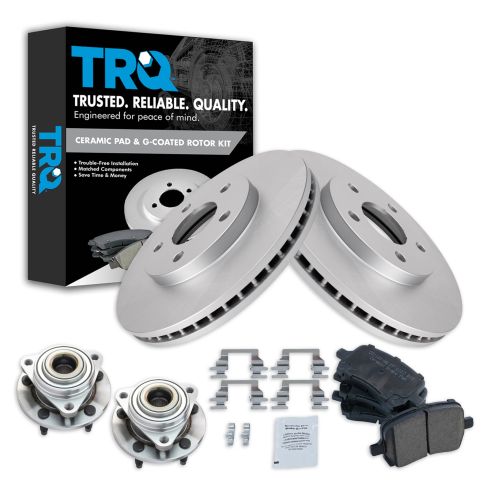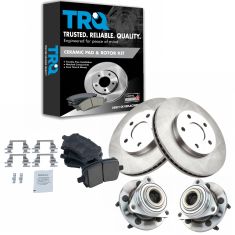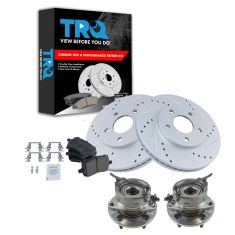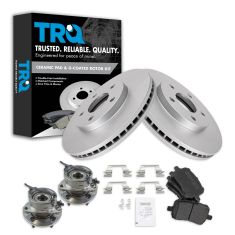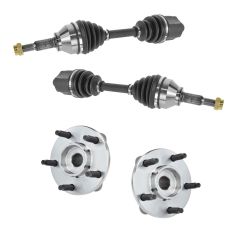Okay, friends. Before we get started, make sure you safely raise and support your vehicle so your wheel is off the ground. Once you've done that, we're gonna remove all five of our 19-millimeter lug nuts. Remove your wheel.
Just to say, we're going to be servicing a lot of things on the front end of this vehicle, so if you see anything that's taken apart, that isn't necessarily in the steps that you need to see. Well, just don't really pay too much attention to that and just follow the steps ahead. All right. Now that we've got the wheel off, let's go ahead and remove the caliper bolts from the caliper bracket sliders. Using a small pry bar, I'm just going to get right in between here and see if I can apply a little bit of pressure and push back this caliper a tiny bit. You can use a wire tie or even a bungee cord. Let's get our pads out of here. Remove your caliper bracket bolts, one here and one up here. Hold that bracket. Now, we're going to remove the rotor. If you notice yours didn't want to come off, you could, of course, give it a couple loving bonks to break it free from the bearing. Before we can go ahead and put on our brand new rotor, you obviously want to clean up the mating surface. You definitely don't want any of this raised area. So, we're just going to sand it down. We'll make it look like it's brand new and we'll continue. Let's go ahead and clean up the rotor braking surfaces. Let's go ahead and put a little bit of copper never-sieze on our hub. Time to install the rotor. And I always like to hold it on with a lug nut. That way there it can't wiggle around.
Now, it's gonna be time to prep our bracket. Let's get everything off of it that doesn't need to be on there. Grab these tins, recycle those. Turn the bracket like this, and remove your sliders. When you remove them, you always want to inspect them. Make sure they're not rotted or pitted in any way. I always like to try to clean them off real quick. This one looks great. I'll set it to the corresponding side. Remove the other one. If you look at this one, you're going to see it has a nice little rubber bushing. If you were to switch this with the other side, you're going to potentially have braking issues. So, always try to make sure you have them on the same side. Some caliper brackets you can try to remove the boot. This one's actually a little bit harder and it actually damages the boot overall. So, if your boots are in good condition after you've inspected them and they're not cracked or damaged in any way, I would just continue on by cleaning out the holes the way I'm going to show you now.
At this point, you're definitely gonna want to have a collection bucket, hand protection, and eye protection. I always have it on at all times, but I'm just gonna mention it. Spray a little bit of parts cleaner inside these holes. Just be careful because fluid will come out. Take a nice bore brush, go right inside there. This is going to clean out any of the debris or gunk that's inside there. Go ahead and dump that out. Nasty. Let's give it a nice rinse. Empty that out. At this point, we need to wait for it to dry. I'm going to keep moving while it dries though and I'm going to clean up these areas of the brackets. The reason why we want to clean up these areas of the brackets is because that's where the tins are gonna ride. On top of the tins is where the pads are. If you have any rot or rust buildup underneath there, it's going to cause an issue with the pads moving inside the bracket, which would be very bad. Use a nice brush, give it a little scrape. If you find that there's large chunks that won't come off, you could try to use a screwdriver or a chisel of some sort. You want to make sure they're as smooth as possible. I have a little sanding disc tool right here that I like to use, so that's what I'm going to do.
The next thing we want to do is use some of our synthetic Moly Grease that came with our kit. I have a little brush here that I like to use. I'm going to go ahead and put it right on there on all those surfaces that I just cleaned up. The reason for adding this lubricant is for vibration dampening, noise reduction, and, of course, it'll keep moisture away from the metal. Something that I like to mention about the caliper sliders is when you're cleaning them, you want to pay special attention to this ridge right here. You want to make sure there's no debris in there or any rough edges. The reason for that is because it needs to connect right here with the boot and it needs to make a good connection and make sure that no moisture can make its way inside there. Once you're sure that you have it nice and clean, go ahead and use some more of that caliper Moly Grease. Go along the whole shaft of the slider and then, of course, make your way up and into that groove. That's gonna be super important. Go ahead and slide it into the corresponding hole. Make sure you did not mix up your sliders and then give it a nice spin just to make sure that the grease is situated. Let's do the same to the other one here. Once you have them both in, just give them a nice spin, and make sure they slide the way they should.
It's time to install our brand new tins. Go ahead and line it up. Squeeze it on there. Make sure it's completely secure. You definitely don't want this coming off. Do the same to both. Let's go ahead and get the bracket on here. I always like to use a little bit of threadlocker on my bolts. Start them both in. We'll snug them up and then we'll torque them to manufacturer specifications. Torque these to 96 foot-pounds. Now, it's going to be time to get our pads on here. But before we do that, we want to make sure that we put on our brake pad wear indicator. To do that, you need to take your pad that you're going to be placing on the inside and you want to pay attention to which corner we want to put it on. I want it to be on the lower half right here, so you can see where it's supposed to fit. Just go ahead and take that indicator and you might need to bonk it on there with something such as a hammer. Just be careful not to damage the meat of the pad. That looks pretty decent. It's completely situated. You want to make sure it's secure so it can't fall off. Go ahead and carefully put this in here. Should flow in there nice and easy. If it feels like you have to force it in or use a hammer, you didn't clean up your brackets enough. Put on the outer pad as well. Perfect.
Now, we need to prep the caliper itself. We're going to put a little bit of that caliper grease right along the metal part of the piston here and then along both of these ears. That's going to help with vibration, dampening and noise reduction overall. Now, we're going to slide this right over the sliders and, of course, over the pads Line up those sliders. We'll put in our slider bolts. Now, we're just going to bottom these out and then we'll torque them to 26 foot-pounds.
So, now, we just want to check the brake fluid level. Make sure it's at the maximum. If it isn't, use the recommended fluid, which is DOT 3 brake fluid. Make sure you close it completely because DOT 3 is hygroscopic and it'll absorb moisture. Make sure you clean down your entire braking surface just in case you have any fingerprints on it. All right. Let's just double-check everything that we fixed here. Looks great. We'll get the wheel up on. We'll start all the lug nuts, snug them up, and then we're going to torque them to 100 foot-pounds. One hundred foot-pounds. Torqued.














